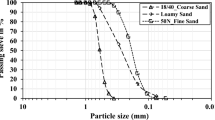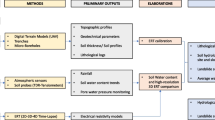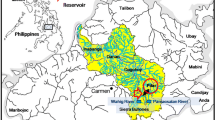Abstract
The major concern for many hydraulic structures is the effect of scour at the toe, when the racing floodwater scours away the bed just downstream of the piers. Therefore, understanding the soil-hydrodynamic interaction needs to be investigated. In this study, a series of 2D laboratory tests have been carried out to study the likelihood of soil scour due to the soil-hydrodynamic interaction and influence of sediment properties. Characteristics such as sediment deposition patterns, longitudinal/lateral spreading length/area, and bed scour profiles for three sediment diameters (i.e. 0.26, 0.30 and 2.40 mm) under dry and wet soil conditions are studied intensively. Experimental results revealed that soil of identical diameters under wet and dry conditions caused significant changes in soil scour rate and deposition patterns. Transport rates in dry condition were much slower than wet condition. It was observed that, for the same flow condition, different soils gave different long term equilibrium deposition patterns due to the grain size distribution and particle shape. Eddies were generated behind the soil samples which resulted in forming a series of ‘crescent’ zones. Findings of this study could offer a qualitative outline of the effects of various parameters to demonstrate a better representation of estimating scour rate in fluvial condition.
Similar content being viewed by others
References
Shirole A.M., Holt R.C., Planning for a comprehensive bridge safety assurance program, Transport Research Record 1290, Transportation Research Board, Washington D.C., 1991, 137–142
Leeks G.J.L., Newson M.D., Responses of the sediment system of a regulated river to a scour valve release: Llyn Clywedog, mid-Wales, U.K., River Research and Applications, 2007, 3(1), 93–106
James L.B., Sediment transport and bed morphology at river channel confluences, Sedimentology, 2006, 35(3), 481–498
Ting F.C.K., Briaud J-L., Chen H.C., Gudavalli R., et al. Flume tests for scour in clay at circular piers, Journal of Hydraulic Engineering, 2001, 127(11), 969–978
Capart H. Liu X. Van Crombrugghe, Young D.-L., Digital imaging characterization of the kinematics of water-sediment interaction, Water, Air and Soil Pollution, 1997, 99(1–4), 173–177
Leonard L.A., Hine A.C., Luther M.E., Super?cial sediment transport and deposition processes in a Juncus roemerianus marsh, West-Central Florida, Journal of Coastal Research, 1995, 11, 322–36
Wang X., Yang Q., Lu W.., Wang X., Effects of bed load movement on mean flow characteristics in mobile gravel beds. Water Resource Manage, Springer, 2011, 25, 2781–2795
Zhao Z., Fernando H.J.S., Numerical simulation of scour around pipelines using an Euler-Euler coupled two-phase model, Environmental Fluid Mechanics, 2007, 7, 121–142
Marriott M., Civil Engineering Hydraulics, Wiley-Blackwell Publishers, 5th Edition, Chapter 14, 2009, 327–359
Van Rijn L.C., Principles of Sediment Transport in Rivers, Estuaries and Coastal Seas, Aqua Publications, Amsterdam, 1993, Chapter 3, 35–37
Whitlow R., Basic Soils Mechanics, Pearson Prentice Hall, 4th Edition, 2001, Chapter 2, 24–28
Author information
Authors and Affiliations
Corresponding author
About this article
Cite this article
Salim, S., Jayaratne, R. Hydrodynamic perspectives of soil scour in fluvial environment. cent.eur.j.eng 3, 541–548 (2013). https://doi.org/10.2478/s13531-013-0112-y
Received:
Accepted:
Published:
Issue Date:
DOI: https://doi.org/10.2478/s13531-013-0112-y




